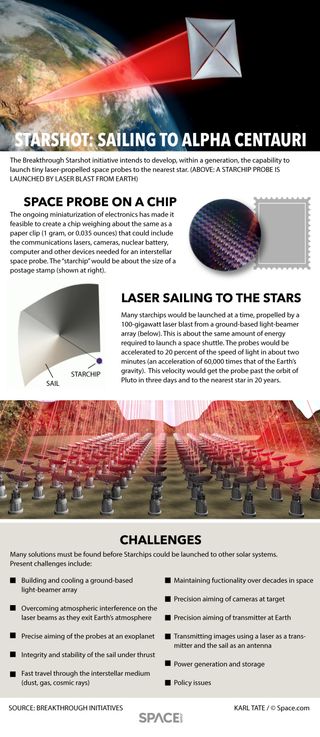How Breakthrough Starshot's Interstellar Probes Would Work (Infographic)

The Breakthrough Starshot initiative intends to develop, within a generation, the capability to launch tiny laser-propelled space probes to the nearest star.
Stephen Hawking Helps Launch Project 'Starshot' for Interstellar Space Exploration
The ongoing miniaturization of electronics has made it feasible to create a chip weighing about the same as a paper clip (1 gram, or 0.035 ounces) that could include the communications lasers, cameras, nuclear battery, computer and other devices needed for an interstellar space probe. The "Starchip" would be about the size of a postage stamp.
Breakthrough Starshot in Pictures: Laser Sail Nanocraft to See Alpha Centauri
Many Starchips would be launched at a time, propelled by a 100-gigawatt laser blast from a ground-based light-beamer array. This is about the same amount of energy required to launch a space shuttle. The probes would be accelerated to 20 percent of the speed of light in about two minutes (an acceleration of 60,000 times that of the Earth's gravity). This velocity would get the probe past the orbit of Pluto in three days and to the nearest star in 20 years.
Stephen Hawking: 'Transcending Our Limits' With Breakthrough Starshot | Video
Many solutions must be found before Starchips could be launched to other solar systems. Present challenges include:
- Building and cooling a ground-based light-beamer array
- Overcoming atmospheric interference on the laser beams as they exit Earth's atmosphere
- Precise aiming of the probes at an exoplanet
- Integrity and stability of the sail under thrust
- Fast travel through the interstellar medium (dust, gas, cosmic rays)
- Maintaining fuctionality over decades in space
- Precision aiming of cameras at target
- Precision aiming of transmitter at Earth
- Transmitting images using a laser as a transmitter and the sail as an antenna
- Power generation and storage
- Policy issues
How Interstellar Space Travel Works (Infographic)
Gallery: Visions of Interstellar Starship Travel
Star Trek's Warp Drive: Are We There Yet? | Video
The Top 10 Star Trek Technologies
Follow us @Spacedotcom, Facebook and Google+.
Join our Space Forums to keep talking space on the latest missions, night sky and more! And if you have a news tip, correction or comment, let us know at: community@space.com.
Get the Space.com Newsletter
Breaking space news, the latest updates on rocket launches, skywatching events and more!

Karl's association with Space.com goes back to 2000, when he was hired to produce interactive Flash graphics. From 2010 to 2016, Karl worked as an infographics specialist across all editorial properties of Purch (formerly known as TechMediaNetwork). Before joining Space.com, Karl spent 11 years at the New York headquarters of The Associated Press, creating news graphics for use around the world in newspapers and on the web. He has a degree in graphic design from Louisiana State University and now works as a freelance graphic designer in New York City.
